Editor's note: Jennifer Musil is senior account director at Communicus Inc., a Tucson, Ariz., research firm.
With billions of dollars being spent annually on advertising by major U.S. advertisers, there is no question that advertising plays a vital role in building brands and influencing consumer choice. While this principle is widely accepted, nearly every advertiser is charged with quantifying the specific return on investment that advertising and integrated marketing communications generates for brands in-market. Further, marketers are pushed to optimize campaigns to achieve specific future performance metrics.
Retrospective or backward-looking advertising research approaches have long been the standard to understand how advertising works in-market and to provide insight into how to optimize future campaigns. Armed with post-campaign performance information and sales data, advertisers can determine the extent to which campaigns (and individual campaign elements) contributed (or failed to contribute) to sales outcomes.
However, there are many influences outside of advertising and other brand-generated content that influence consumer choice. These influences are growing in the age of instant connectivity to online reviews, “expert” opinions, product information and ease of word-of-mouth communication through a wide network of friends and family. Thus, for marketers to drive the strongest results on the bottom line, they need to understand how advertising interacts with other marketplace influences.
Once marketers understand the specific role of each potential influencer in driving demand, and the relationship between advertising and other influences, they can move from backward-looking assessment to more accurate forward-looking planning and prediction. Because advertising is the one variable where marketers retain the most control, the insights gained can be used in the planning phases for future campaign initiatives.
Questions to be addressed revolve around how a campaign can be optimized to:
- drive stronger demand (through looking at overall campaign changes and the messages/creative approaches utilized in different media venues);
- facilitate strong positive word-of-mouth dynamics via conversation, reviews, social media, etc.;
- perform best in light of competitive influences on consumer choice; and
- deliver the most persuasive messaging possible.
Once advertisers have a clear, quantitative snapshot of how all marketplace forces interact to influence demand, they can then move from the theoretical approach of understanding influences on consumer choice to using these models to quantitatively predict future demand. By quantifying the strength of each influence, these models allow for planning and development of what-if scenarios that can illuminate the path to building the strongest future demand for the brand via changes in the advertising campaign.
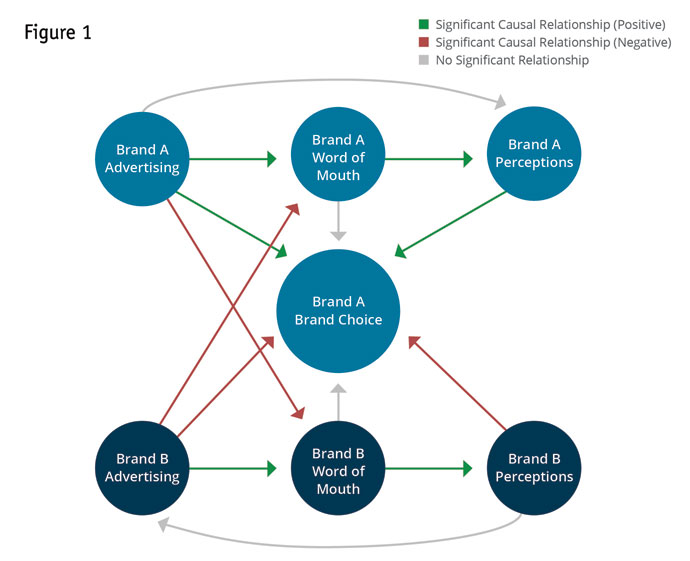
Mapping relationships
Structural equation modeling (SEM) is the analytic tool that creates a holistic view of marketplace forces on consumer choice by mapping relationships between various influences to ultimately predict future demand.
Our firm recently utilized these models within the mobile device industry to identify the role that advertising and non-advertising influences played in driving purchase intent for key brands, including Apple, Samsung, Windows, Amazon and LG, all of which had recent advertising campaigns in market. This study was designed to not only determine how recent campaigns drive purchase intent for each brand and the featured devices but to also highlight the full causal chain of influence on brand choice, including the role that word of mouth, preexisting perceptions and competitive actions play in effecting brand choice.
To develop the most robust models and ensure the most accurate analysis, the study was conducted longitudinally – that is, the same 628 adults were interviewed at two points in time. The first interview occurred prior to campaign launch for all brands and the second interview was conducted after each campaign had been in-market for several months. The use of the longitudinal design allows for a clear picture of how perceptions and purchase intent for each brand change over time and in relation to the specific combination of influences that each consumer was exposed to and/or engaged with. The potential influences included in this study were:
- video advertising (television and online video);
- digital advertising;
- sponsorships, promotions and brand integrations;
- social media engagement – brand-sponsored/generated;
- social media engagement – family/friends-generated comments and content;
- blog engagement;
- word of mouth – the opinions of family or friends about the brand;
- family and friends’ purchasing behavior;
- in-store experts; and
- existing brand perceptions and purchase intentions.
Data was collected in both the pre- and post-campaign research phases around various brand health metrics for all brands, including awareness (aided and unaided), brand perceptions, future purchase intentions and current device ownership. In the post-phase, the research determined the specific influencers for each brand that consumers had engaged with over the course of the campaign using a proven set of memory triggers (proven 90 percent accurate up to a year after initial exposure).
By comparing pre- and post-data for individual respondents, a clear picture emerged of what brand metrics had changed over time as well as which specific influences or combination of influences each consumer had engaged with. These inputs were used to develop the structural equation models – a model of marketplace influences on brand choice specific to the mobile device industry.
The resulting model clearly highlights how the various influences interact to drive brand choice. For the sake of this article, the model has been simplified to include interactions between the two leading brands: Apple and Samsung. However, these models can be utilized across a more broad set of competitors. During the time frame of the research, Apple was running advertising for its iPhone 5 and iPhone 6 devices, and both AT&T and Verizon were featuring the iPhone in their advertising (“Carrier” spots). Samsung was in-market with Galaxy-focused executions and was also running some Apple-bashing spots around the launch of the iPhone 6.
The first step in this analytic approach is to identify if there are relationships between various influences. In this case, three categories of influence emerged.
1. Advertising. This includes TV, digital and brand-generated social media content for the respective brand, as well as sponsorships and promotions.
2. Word of mouth. This includes word-of-mouth (family or friends saying something about a brand), interaction with in-store experts, recent purchases by friends/family and social media and blog content generated by friends/family.
3. Brand perceptions. This includes pre- and post-campaign perceptions for each brand across a variety of brand dimensions.
Once these groups of influence are established, the model then highlights the causal relationships between each of the three categories of influence and with demand (brand choice, as reflected by future purchase intentions). This provides a clear picture of how various influences affect one another and, ultimately, generate demand.
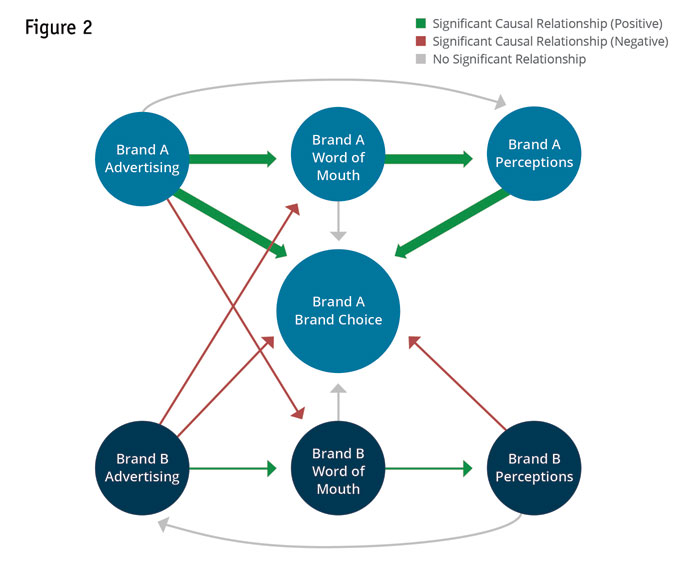
Interesting dynamics
Several interesting dynamics emerge in this model to provide insight into what influences drive consumer choice, how competitive dynamics effect choice and the relationship between the various influences.
Word of mouth is critical in maximizing the ultimate impact on brand/device demand. One of the most important findings from this model is that while advertising does generate a positive influence on demand for the featured device, the effect is somewhat stronger when word of mouth is involved in the equation. If we evaluate the following two paths to demand, we find that the path that includes a word of mouth (WoM) component actually has a stronger effect on demand. That is, while advertising does work to directly influence brand choice, it is particularly effective at driving conversations (WoM) among consumers, which improve brand perceptions, which then lead to increased demand.
Further exploration into the path from advertising to demand via WoM and perceptions highlights which perceptions are most critical for each brand to build via advertising and WoM in order to increase brand choice. In the case of Apple and Samsung we find that different perceptions drive demand for the respective brand/device.
In the case of Apple, increases in demand are most significant when perceptions that the brand “has the best features and functionality,” “is easy to use” and “is worth paying more for” improve. Conversely, Samsung benefits most significantly from improvement in “has great aesthetics” and “is worth paying more for” perceptions. Understanding the key drivers of purchasing for each brand (and key competitors) can help marketers to optimize advertising messages and positioning.
When digging deeper into the direct path between advertising and demand metrics, the study found that television and digital advertising are significant drivers of demand for Apple and Samsung, while brand-generated social media and sponsorships/promotions play more of a supportive role. While these supportive media do have an influence, their power to influence brand choice is strongest when they are seen in conjunction with television or digital advertising. However, the importance of these media should not be underestimated – they often contribute on a very cost-efficient basis and can help to increase campaign intensity (the extent to which the consumer is “surrounded” by brand messages).
Advertising does not have a direct effect on overall brand perceptions. While advertising is certainly able to influence individual brand perceptions, this model tells us that advertising does not have a direct effect on overall brand perceptions. Thus, it is unlikely, in the mobile device space, for advertising to generate a fundamental shift in overall brand perceptions without the benefit of other influences.
Instead, our research finds that while advertising helps to build select brand perceptions for both Apple and Samsung, the fundamental way that consumers view a brand is not impacted without exposure to some supporting word-of-mouth influences. In other words, consumers are more likely to believe the claims they hear on TV if they are validated via word-of-mouth dynamics – for example, hearing friends and family say something good about a brand or learning about the brand from an in-store expert.
Word of mouth is impactful but it must change the way that consumers perceive the brand. Word-of-mouth dynamics – including hearing good things about a brand from family and friends, hearing that family and friends have purchased a specific device, seeing family- and friend-generated content about a brand on social media and talking with an in-store expert – play an important role in changing the way the consumers perceive a brand, which in turn, drives increases in demand for a brand. However, without this perceptual change, word of mouth is not, in isolation, a significant driver of brand choice.
The good news for marketers is that word-of-mouth dynamics are highly effective in changing brand perceptions, as evidenced by the direct relationship between the two factors. Thus, when marketers can use advertising to fuel conversations about brand benefits and features in the marketplace, the result is often substantial perceptual change and increased demand.
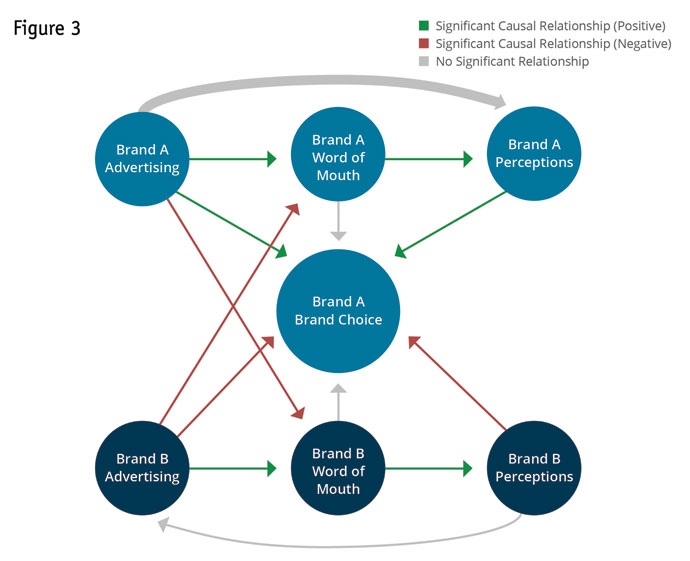
There are strong competitive interactions in the mobile device space (as in most category landscapes). While it is important for researchers to understand the tools and tactics that they can use to drive demand for their brand, it is equally important to understand where the brand is vulnerable to competitive influences. In the mobile device space, we find that there are plenty of competitive dynamics which will directly affect brand choice.
In the case of Apple and Samsung, engagement with a competitive brand’s paid media campaign (TV, digital, social, etc.) has the potential to directly affect demand for the opposing brand. Additionally, competitive advertising can temper positive word-of-mouth dynamics for other category brands. The overall effect of these negative influences depends on the strength of the respective advertising campaign; is it engaging, well-branded and highly persuasive? How successful is it at generating conversation and chatter in the marketplace? The stronger the competitive campaign, the stronger the negative implications for other category brands.
In looking specifically at Apple and Samsung dynamics, Apple-generated social media is particularly effective in negatively impacting demand for Samsung. Conversely, Samsung advertising that focuses on Samsung benefits is more successful in decreasing demand for Apple than are their direct Apple-bashing campaign themes.
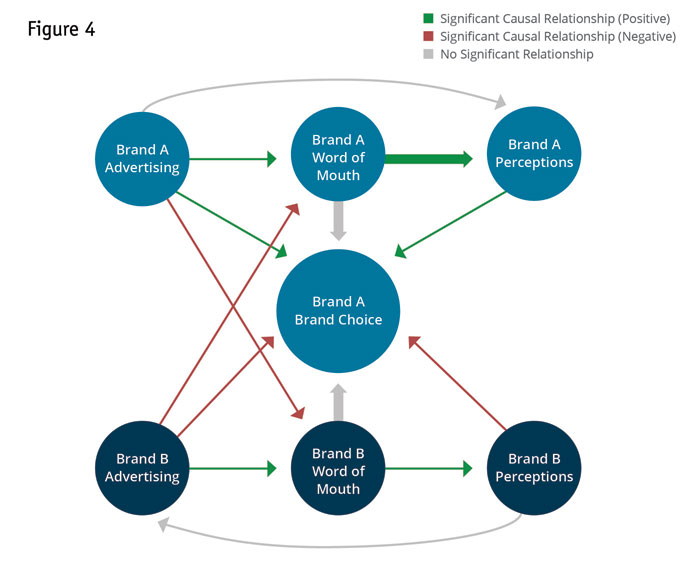
Provide the most accurate picture
When deciding to develop and leverage structural equation modeling as part of the research toolkit, there are several practices that can ensure that the models provide the most accurate picture of the market and the strongest predictive value.
- When designing research, plan to include a very robust set of potential influences on consumer choice. The model will sort out those that are not impactful or predictive of demand.
- If the goal is to develop a model that can be used across multiple campaigns (as opposed to being designed to evaluate a single point in time among a set of given brands), it is recommended that multiple time periods and campaign evaluations be included in model development to ensure the most robust picture of “typical” marketplace dynamics. Robust sample sizes are also required.
- To determine which specific influences fall into each bucket within the model, an empirical approach can be utilized (exploratory factor analysis), as was in this research, or buckets of influences can be grouped based on theory. It is recommended that researchers use empirical approaches first and then use theory to make the groupings more granular if there is a desire to look at specific influences in isolation or in smaller groups than model generates.
- When developing an SEM model, marketers must work with analysts to develop several hypotheses on how the model might look – how the various buckets of influence might work together to influence demand. (The model will not develop the overall picture of influence without a suggested starting point.) By having several starting hypotheses, data can be run through various hypotheses to determine which models/hypothesis best fit reality.
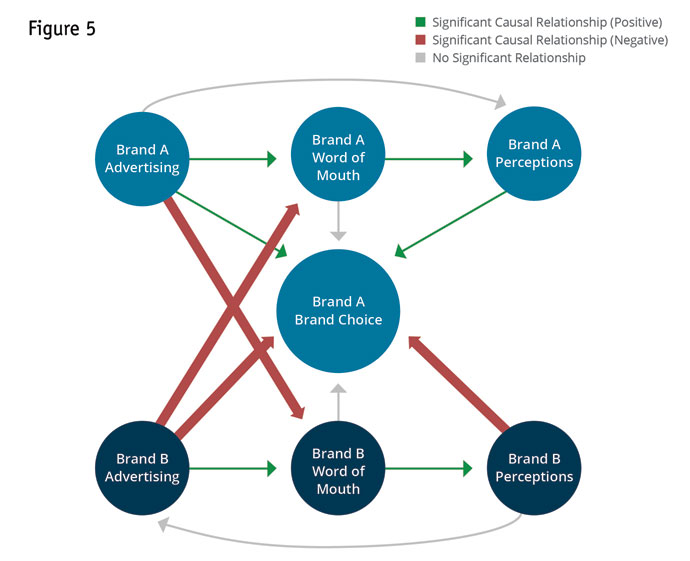
Optimize future campaign performance
While these models provide valuable insights into current marketplace dynamics that will help to optimize future campaign performance, they can also be used to predict demand and/or future brand health, as the models can be structured to predict any key performance indicator (dimensions other than future brand choice/demand as was used here).
Marketers can use pre-campaign brand perceptions (collected during the first phase of the longitudinal design), coupled with assumptions about future campaign performance gathered from pre-testing results, via early campaign research or based on backward-looking assessment of previous campaigns, to forecast demand using these models. In this way, these models help marketers to design more effective campaigns, make tweaks to new campaigns to optimize ROI early in the media plan and to identify the advertising approach that will produce the strongest outcome (demand) for the brand.
Key findings
The use of SEM models provides valuable learning across the chain of influence that ultimately determines consumer purchase intent and purchasing. In the mobile device space, this approach has helped to highlight several key findings:
- Advertising can be used to directly drive demand but it is particularly impactful in driving positive word-of-mouth in the marketplace, which in turn can change brand perceptions – leading to brand choice.
- Use of this type of model provides valuable insight into which specific brand perceptions are the strongest drivers of increased demand for both the brand of interest and for competitors – important information to drive future campaign messaging and brand positioning.
- Competitive interactions are very strong and brands with strong campaigns and relevant messages have great potential to negatively impact competitive brands. Marketers who do not account for these interactions do so to their peril.
- By understanding and estimating marketplace influences, marketers can generate accurate predictions of future brand health and performance and work to manipulate various influences to achieve future marketing objectives.
The chain of influence
By evaluating various influencers on brand choice in isolation (such as via advertising-only focused retrospective research), marketers are missing out on the big picture. While it is important to understand how all of the individual elements are working for a brand in isolation, understanding the chain of influence across the marketplace provides important insight into how brand can leverage these dynamics to maximize demand. This approach also lets marketers make much more accurate predictions about future brand health and demand, thus enabling brands to be proactive rather than reactive about how to leverage various influences to optimize ROI.
